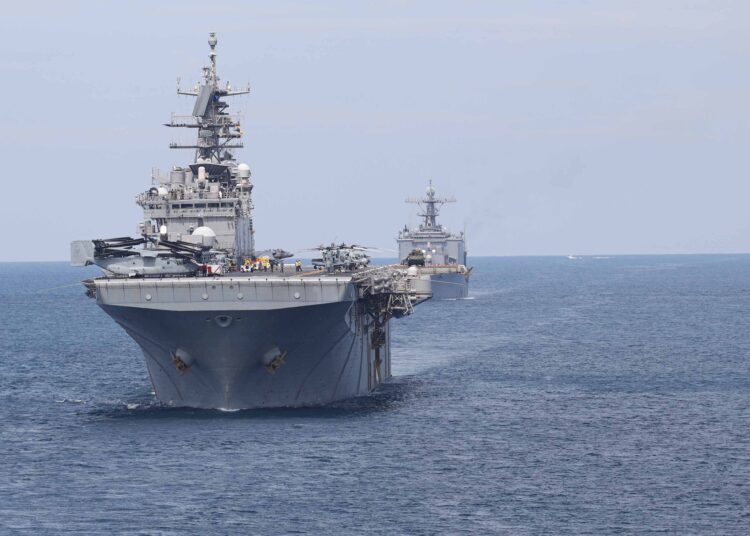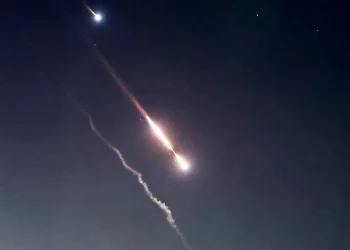The maritime stalemate between Iran and the United States in the Persian Gulf, among other global locales, has acquired new dimensions in recent months.
The United States has conveyed its intentions to dispatch additional warships, thousands of Marines, an array of F-16 fighter jets, the destroyer “USS Thomas Hudner”, and a number F-35 jets to the Persian Gulf in an attempt to thwart Iran. US Defense Secretary Lloyd Austin on Thursday, July 20, approved the deployment of the USS Bataan amphibious readiness group and the 26th Marine Expeditional Unit to the Persian Gulf.
American officials have purported these airborne fighters are intended to furnish overhead protection for vessels cruising through the strategically vital shipping artery, the Strait of Hormuz. This move, it is contended, stems from Iran’s seizure of American oil tankers. John Kirby, the spokesperson for the US National Security Council, has said that the US, with the support of global allies and regional partners, will respond to Iran’s maneuvers, aiming to secure unimpeded navigation via the Strait of Hormuz and other essential waterways.
Iran swiftly retorted to these pronouncements. Iranian military officials issued their own warnings against American “provocations” in the Persian Gulf. On July 19, Iranian Defense Minister, Brigadier General Mohammad-Reza Ashtiani, stated, “The Islamic Republic is in a phase of authority and capability where it stands immune to threats.”
Evolving Dynamics of Iran-US Conflicts in the Persian Gulf
The maritime stalemate between Iran and the United States in the Persian Gulf, among other global locales, has acquired new dimensions in recent months. Shahram Irani, commander of Iran’s Navy, on April 18 said, “The pervasiveness of piracy within the region is the direct fallout of the US’s unjustified presence in the region, and their bolstering of pirates deteriorates the situation in the region.” He called for the withdrawal of US forces from the Persian Gulf. Merely two days subsequent, this commander disclosed a thwarting of a covert intrusion by an American submarine into the Strait of Hormuz by Iran’s own submarine, “Fatih”. The cryptic US vessel, he proclaimed, had been silently approaching Hormuz underwater before detection by Fatih and was subsequently forced to navigate surfaced.
Brad Cooper, commander of US Naval Forces Central Command, said on June 15 that his country plans to dispatch over 100 unmanned surface vessels, also known as maritime robots, to the Persian Gulf before summer’s close. The aim, he argued, is for the US and its allies to pinpoint threats from countries akin to Iran more rapidly and accurately.
The US Navy, in its turn, communicated on July 6, that it had obstructed Iran’s attempt to seize two oil tankers in the Gulf of Oman. Concurrently, the US Navy’s spokesperson reported an Iranian Revolutionary Guard Corps’ (IRGC) capture of a merchant vessel within the waters of the Persian Gulf.
During the last couple of years, Iran has purportedly seized at least five vessels attempting to traverse the Strait of Hormuz and compelled a dozen more to turn back. Iran frequently says the seized vessels had violated regulations, while in practice those could be assumed as reciprocal responses to US ‘provocations’, like seizing its oil tankers across the globe.
On July 20, General Alireza Tangsiri, Commander of the IRGC Navy, referred to the anniversary of a 2018 incident wherein a UK oil tanker was seized. He said, “Our present era has transcended the time of hit and run. If we are hit, an apt response should be anticipated. Furthermore, we pledge to hold accountable any oil company unloading our oil from a seized tanker. The United States also bears responsibility.”
In a related maritime incident, the Indonesian Coast Guard made the pronouncement on July 11 about the seizure of an Iranian oil tanker named “Arman 114”, citing charges of unlawful oil transportation. This operation has been attributed, by many, to an alliance with American interests. However, Iran’s Ministry of Oil, asserted the impounded tanker’s cargo did not have Iranian ownership.
Adding to the slew of developments, on July 18, the Wall Street Journal, relying on undisclosed US sources, reported that American companies abstained from offloading the Iranian cargo within a Greek oil tanker, fearing potential retaliation from Tehran. This vessel currently resides off the Texan coastline.
The maritime quagmire between Iran and the United States reached new heights in relation to Iran’s bid to host the International Maritime Organization (IMO) meeting. Due to the intervention of the United States, which was outward, Tehran’s proposal to host the IMO meeting on World Maritime Day was rebuffed.
Iran’s Ministry of Foreign Affairs spokesman, Nasser Kanaani, on Friday, July 21, sharply critiqued this obstruction, stating “The actions of the United States, abetted by the United Kingdom, make it evident that their relentless political exploitation of technical UN bodies knows no boundaries, even at the expense of undermining their legitimacy.”
Iran’s perception of US presence in the Persian Gulf
The ongoing cold war in the Persian Gulf between Iran and the United States is as aged as the Islamic Revolution in Iran itself and dates back to the founding days of the Islamic Republic of Iran. The fall of Iran’s Pahlavi dynasty equated to the collapse of one of the United States’ strategic security pillars in the Persian Gulf, sounding the starting gong of a contentious epoch between Iran and the United States in this geopolitically important region. Once considered the regional gendarmerie of the United States from 1969, Iran metamorphosed in 1979 into the key opponent of the United States’ presence in the Persian Gulf. Four decades have witnessed these two nations tread the precipice of military confrontation, yet have consistently retreated from a definitive and direct showdown.
For Iran, viewing through the lens of threatening power and intentions, the US military presence inserts other concerning elements such as geographical proximity and increased offensive capabilities into the strategic equation. Within this framework, the United States’ presence in the Persian Gulf is viewed as a strategic threat to the national security of Iran. In response, Iran has adopted a deterrent strategy limiting further access of the US to the Persian Gulf.






